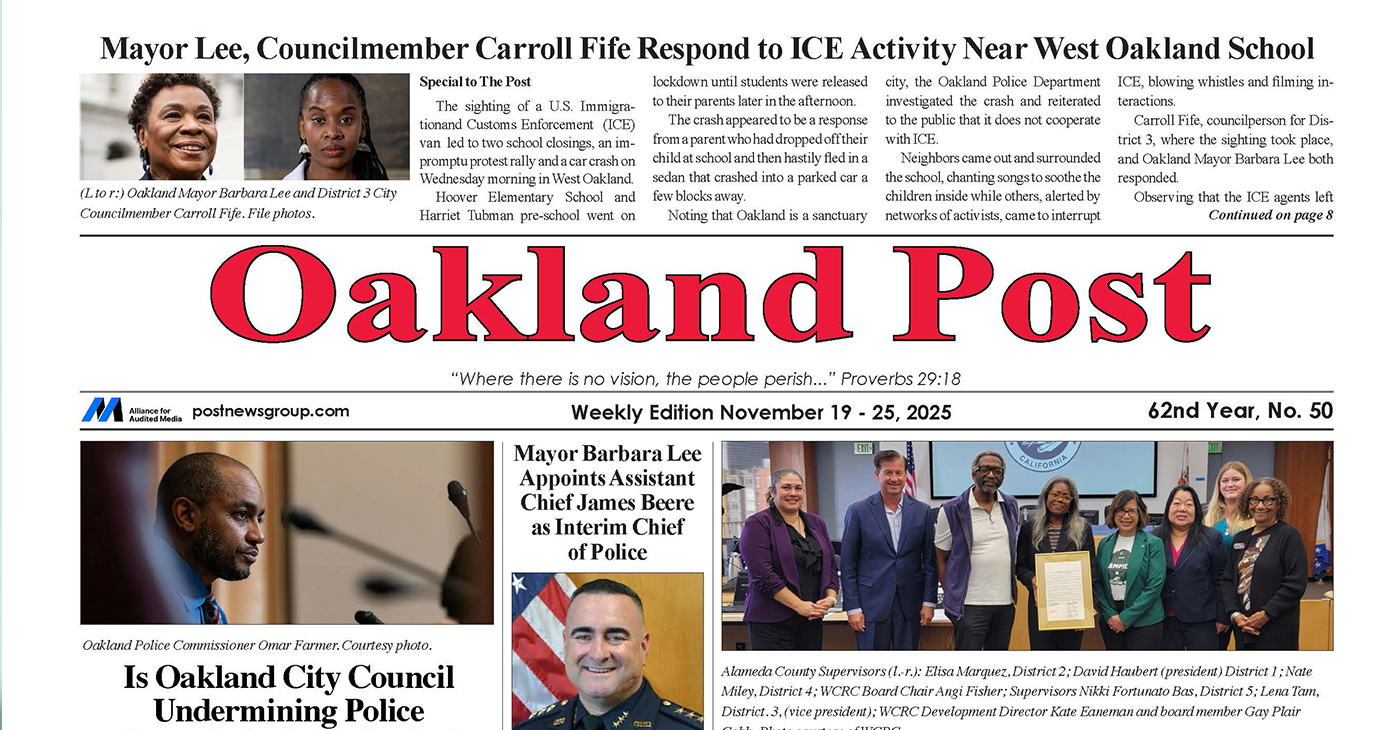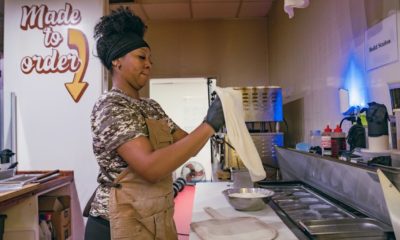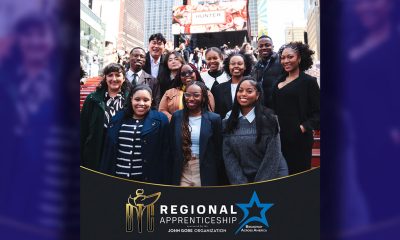Business
Black Business Spotlight: Junita’s Jar
MINNESOTA SPOKESMAN-RECORDER — Junita Flowers has been in the cookie business for the past 10 years. She first launched her successful Favorable Treats in 2009, but an abusive marriage and divorce left her picking up the pieces. Instead of giving up, she relaunched with a purpose.
By Stephenetta (isis) Harmon
Junita Flowers has been in the cookie business for the past 10 years. She first launched her successful Favorable Treats in 2009, but an abusive marriage and divorce left her picking up the pieces. Instead of giving up, she relaunched with a purpose.
Her new cookie imprint, Junita’s Jar, not only offers up sweet treats but also provides healing for women affected by relationship violence and prevention for others. Since launching last summer, she’s focused on expanding her reach and using the power of food to connect communities.
The MSR caught up with the cookie entrepreneur to talk about her mission-driven company and her plans to change the world, one cookie at a time.
MSR: So can you tell me a little bit about Junita’s Jar?
Junita Flowers: Our mission is to bake hope into every cookie purchased. We have three different flavors — triple chocolate chip, oatmeal peanut butter chocolate chip, and oatmeal raisin.
We are specifically focused on college students, because the 18 to 24 demographic is the largest impacted by relationship violence. And college students can impact change in our culture — sometimes faster than any other generation — because they’re willing to go against the odds and try things and support each other on a different level.
Ultimately, our goal is to reduce victim-shaming, create allies amongst peers, and then inspire students to take action beyond what we call our “Cookies and Conversation” event.
MSR: What does a Cookies & Conversation event look like?
JF: [Hosts] bring their friends together, they book the space. I bring in a panel of experts, I host the conversation, I bring in the cookies. I have someone that represents mental health talking about trauma, the impact of trauma on the brain, managing stress, and self-care. I have a medical professional [who] talks about what you can expect if you ever find yourself in a situation and what you can expect from the medical community.
And then I have a survivor who is no longer in trauma. If you go volunteer at a shelter, you’re meeting women in trauma and you sometimes don’t relate to them. But if you see a woman that’s now on the other side, you can kind of relate to her, like, “You had a regular relationship like I thought I had.”
We’re really trying to normalize, not so you can be okay with it but to let women know it can happen to any of us. One in four women [are victims of relationship violence]; that’s not just a stat, that’s real.
MSR: What inspired you?
JF: I am a survivor of domestic violence. It’s not a topic that I was necessarily passionate about, but I knew I was passionate about changing women’s lives and I didn’t want anyone to feel the way that I did. I knew that I wanted to create something different, something hope-filled. I didn’t want women to feel the way I did.
MSR: How does all this tie into cookies?
JF: Cooking was my emotional escape. During the craziness of the abusive relationship, I went back to what I knew and what brought me joy as a child — being in the kitchen. I am one of eight [children], and my grandmother used to come over every Wednesday to help my mom prepare meals, so we spent a lot of time in the kitchen making everything from scratch.
It was just the bonding that happened in the kitchen. And cookies are the thing that I decided to do. What fed me in the craziness is what now is going to feed my family and others — literally and figuratively.
Even though we sell cookies, I like to think that we’re a story-sharing platform. We use the cookies as an opportunity to spark conversation.
MSR: What’s next?
JF: I have my next C&C scheduled for August with a student nurses association, and then I have some conversations that I’m super excited about that are coming up that I’m hoping will lead me to my ultimate goal. I want every student-athlete that enters a college campus to go through our conversation series as a part of their orientation — sort of an education and prevention mechanism around sexual and domestic violence. So I’d like to partner with the NCAA.
MSR: Any other goals?
JF: Our tagline is “hope munches on,” so I would like to go around the world speaking and inspiring women — not just about relationship violence, but inspiring women to push beyond boundaries and pursue their purpose, because that’s an area where women tend to struggle the most. You could be 30 or 60 and still struggle with that whole thing around purpose.
MSR: Do you have any plans for retail?
JF: That’s sort of the next step as we build awareness and build our customer base. We’re at the University of Minnesota, in about five stores and the four bookstores on campus, and we’re in a store on Grand Avenue in Saint Paul. Once people are more aware of who Junita’s Jar is, we can have better success once we get on the retail shelves.
MSR: What advice would you give to someone who was looking to start a commercial business combining the social enterprise aspect?
JF: I think it all boils down to your why — why are you in business? How do you know if this is for you, if this is what you want to do? Think if you are really tapping into your “why.” You should dream about your why, research your why, plan your why, execute that why, celebrate that why, and then repeat it.
For more info, visit Junita’s Jar at junitasjar.com.
This article originally appeared in the Minnesota Spokesman-Recorder.
Alameda County
Seth Curry Makes Impressive Debut with the Golden State Warriors
Seth looked comfortable in his new uniform, seamlessly fitting into the Warriors’ offensive and defensive system. He finished the night with an impressive 14 points, becoming one of the team’s top scorers for the game. Seth’s points came in a variety of ways – floaters, spot-up three-pointers, mid-range jumpers, and a handful of aggressive drives that kept the Oklahoma City Thunder defense on its heels.

By Y’Anad Burrell
Tuesday night was anything but ordinary for fans in San Francisco as Seth Curry made his highly anticipated debut as a new member of the Golden State Warriors. Seth didn’t disappoint, delivering a performance that not only showcased his scoring ability but also demonstrated his added value to the team.
At 35, the 12-year NBA veteran on Monday signed a contract to play with the Warriors for the rest of the season.
Seth looked comfortable in his new uniform, seamlessly fitting into the Warriors’ offensive and defensive system. He finished the night with an impressive 14 points, becoming one of the team’s top scorers for the game. Seth’s points came in a variety of ways – floaters, spot-up three-pointers, mid-range jumpers, and a handful of aggressive drives that kept the Oklahoma City Thunder defense on its heels.
One of the most memorable moments of the evening came before Seth even scored his first points. As he checked into the game, the Chase Center erupted into applause, with fans rising to their feet to give the newest Warrior a standing ovation.
The crowd’s reaction was a testament not only to Seth’s reputation as a sharpshooter but also to the excitement he brings to the Warriors. It was clear that fans quickly embraced Seth as one of their own, eager to see what he could bring to the team’s championship aspirations.
Warriors’ superstar Steph Curry – Seth’s brother – did not play due to an injury. One could only imagine what it would be like if the Curry brothers were on the court together. Magic in the making.
Seth’s debut proved to be a turning point for the Warriors. Not only did he contribute on the scoreboard, but he also brought a sense of confidence and composure to the floor.
While their loss last night, OKC 124 – GSW 112, Seth’s impact was a game-changer and there’s more yet to come. Beyond statistics, it was clear that Seth’s presence elevated the team’s performance, giving the Warriors a new force as they look to make a deep playoff run.
Activism
Oakland Post: Week of November 26 – December 2, 2025
The printed Weekly Edition of the Oakland Post: Week of November 26 – December 2, 2025

To enlarge your view of this issue, use the slider, magnifying glass icon or full page icon in the lower right corner of the browser window.
Activism
Oakland Post: Week of November 19 – 25, 2025
The printed Weekly Edition of the Oakland Post: Week of November 19 – 25, 2025

To enlarge your view of this issue, use the slider, magnifying glass icon or full page icon in the lower right corner of the browser window.
-

 Activism3 weeks ago
Activism3 weeks agoOakland Post: Week of November 12 – 18, 2025
-

 Activism4 weeks ago
Activism4 weeks agoOakland Post: Week of November 5 – 11, 2025
-

 Activism2 weeks ago
Activism2 weeks agoIN MEMORIAM: William ‘Bill’ Patterson, 94
-

 Activism3 weeks ago
Activism3 weeks agoHow Charles R. Drew University Navigated More Than $20 Million in Fed Cuts – Still Prioritizing Students and Community Health
-

 Bay Area3 weeks ago
Bay Area3 weeks agoNo Justice in the Justice System
-

 #NNPA BlackPress3 weeks ago
#NNPA BlackPress3 weeks agoThe Perfumed Hand of Hypocrisy: Trump Hosted Former Terror Suspect While America Condemns a Muslim Mayor
-

 #NNPA BlackPress2 weeks ago
#NNPA BlackPress2 weeks agoTrump’s Death Threat Rhetoric Sends Nation into Crisis
-

 #NNPA BlackPress4 weeks ago
#NNPA BlackPress4 weeks agoProtecting Pedophiles: The GOP’s Warped Crusade Against Its Own Lies
























































